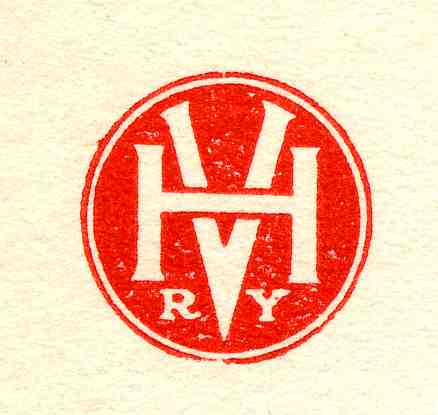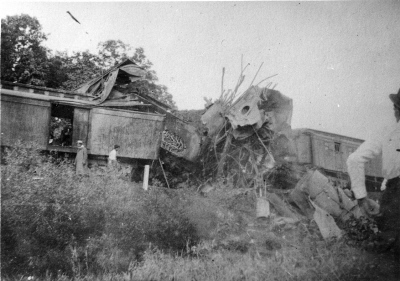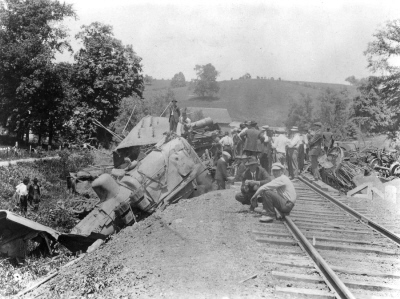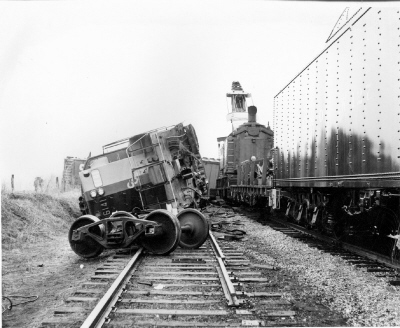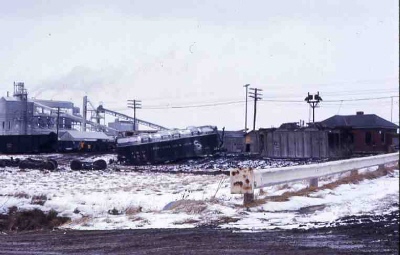|
|
WRECKS, ACCIDENTS and DERAILMENTS |
|
Wrecks
|
Most of the wrecks included on this page were not covered in the The Hocking Valley Railway book. An exception is the two photographs of the 1914 wreck near Starr. Also included are some wrecks that occurred after the C&O merger on April 30, 1930. Information for this page came from accident reports found on the U.S. Department of Transportation website. Just North of Starr ― June 13, 1914
B&O Crossing in Fostoria ― June 15, 1916 On June 15, 1916, a northbound freight train on the Hocking Valley Railway collided with an eastbound express train on the Baltimore and Ohio Railroad at the crossing of these lines in Fostoria. The accident resulted in the death of one express messenger and the injury of another express messenger The HV freight train (second No. 65) consisted of 61 loaded cars behind locomotive No. 157. It had left Mound Street Yard in Columbus at 10:15 p.m. the previous day. The last stop the HV train made was at Carey, 13.8 miles south of Fostoria, where the seventh car was set out. The engineer made a brake application about three quarters of a mile south of the crossing slowing the train from 25 miles per hour to 15 miles per hour. By this time, the engineer could see the tilting target at the crossing was set for the B&O and made a second brake application. When the brakes did not respond, the engineer put the train in emergency. When the HV train was about 600 feet from the crossing, the B&O train started across it. Unable to stop, the HV train hit the fourth car of the B&O train. The eastbound B&O express No. 14 had 11 baggage and express cars, hauled by locomotive No. 1436. It left Garrett, IN, at 4:31 a.m., 36 minutes late. At Deshler, OH, two cars were set out and one added. The train stopped at the Nickel Plate Road Crossing, proceeded east, stopped at the HV Crossing, and started over the crossing when it was struck by the HV freight train at about 7:10 a.m. Both the head end and rear end crews of the HV train started walking along the train checking the air line couplings between the cars. The engineer found an angle cock half closed on the twelfth car. Both the Conductor and an employee of a local industry had seen a man run from the train as it was trying to stop. In the end, blame was put on the HV engineer, who otherwise had a good service record. Linworth ― June 24, 1924 A rear end collision occurred between two extra trains on single track 1370 feet north of the depot at Linworth at 4:15 a.m. on June 24, 1924. A dense fog reduced the range of vision to a distance of about four car lengths at the time of the accident. Wreck train extra 255 (south) with seven cars and a caboose left Powell, five miles north of Linworth, at 3:41 a.m. with the block already occupied by three helper engines. Approaching Linworth, while moving at a speed of about 3 miles per hour preparing to stop for water, the rear of the train was struck by extra 138. Freight train extra 138 south consisted of 39 loaded ore cars and a caboose. The train left Walbridge at 3:45 p.m., June 23rd, passed Powell at 3:53 a.m., 12 minutes behind extra 255, and while traveling at a speed of about 9 miles per hour collided with extra 255 near Linworth. The accident destroyed the caboose of work extra 255, damaged the two preceding cars, and resulted in the death of the work train's rear brakeman. The force of the impact shoved work extra 255 forward about 5 car lengths. The primary cause of the accident was the failure of the conductor and the flagman of work extra 255 to properly protect their train by dropping lit fusees as their train slowed. The secondary cause of the accident was the speed at which extra 138 was moving. The biggest cause, however, was the dense fog, and the lack of a signal system. Upper Sandusky ― March 11, 1932 A rear end collision occurred between two freight trains on the westbound main track 905 feet west of the east switch of the center siding at Upper Sandusky at about 12:30 a.m. The weather at the time varied from broken clouds to light snow flurries. Westbound extra 3026 left Parsons at 8:05 p.m., March 10, with 125 cars and a caboose. The train set out 30 cars enroute, arrived at Upper Sandusky at 11:25 p.m., picked up two cars and was attempting to depart when a knuckle broke near the center of the train. After standing for about 25 minutes, the caboose was struck by train No. 91 Westbound train No. 91 with engine 3005 consisted of 53 cars and a caboose. The train left Parsons at 9:40 p.m., March 10, set out 22 cars and picked up 5 cars at Marion, and passed Morral at 12:22 a.m. The train passed two automatic signals without the signal indications being observed by the engine crew, passed the flagman of extra 3026, and collided with the rear end of extra 3026 while traveling at a speed estimated to have been between 25 and 40 miles per hour. The caboose and the rear seven cars of extra 3026 were derailed, as were engine 3005, the first seven cars and the thirty-second car. Employees injured were the engineer, fireman and head brakeman of No. 91. The accident occurred due to the failure of the engineer, fireman and head brakeman to observe and obey the signal indications for which they were responsible. B&O Crossing in Fostoria ― November 12, 1940 A side collision occurred when a C&O yard crew returning from the Nickel Plate's Blair Yard with 121 cars did not stop on signal indication and was struck in the tender by eastbound B&O passenger train No. 46. The accident occurred at 3:15 a.m. The weather was clear. C&O yard engine No. 227 (an 0-8-0) running backwards with helper engine No. 520 on the rear left the Nickel Plate's Blair Yard at 3:05 a.m. The eastbound B&O passenger train No. 46 with engine No. 5233 (a 4-6-2) had six cars. The train left Garret, IN, at 1:13 a.m. It had made a station stop at Fostoria, and departed east with a clear signal at the C&O Crossing. The B&O passenger train was moving at between 10 and 15 mph when it struck the C&O yard train. The accident occurred because the C&O yard engineer did not properly observe and obey the signal crossing signal indication at the C&O/B&O crossing, which at that time was a tilting target. It resulted in the death of the C&O yard conductor, who was riding in the fireman's seat. Presque Isle Yard in Toledo ― April 11, 1944 A sideswipe collision occurred when a cut of six cars hit engine No. 1295 (a 2-6-6-2, former HV 220) demolishing its cab. It was hazy at the time of the accident, which occurred at 12:20 a.m. Yard engine 1295, headed southward, was moving northward on Track No. 3 at an estimated speed of 4 mph when it was struck by the first car of a cut of six cars. The cars had been detached from engine 1275 on track No. 2. The cars hit engine 1295 due to a crossover switch not being lined for the intended movement. The employee killed was the fireman of engine 1295. The employees injured were the conductor and engineer of engine 1295. Just West of HV Junction at Columbus ― March 25, 1945 The trailing engine truck derailed on the curve near HV Junction when the engine-truck rocker device failed. The derailed truck rode the ties parallel to the track for almost one mile until encountering a switch just north of Fifth Avenue (MP 2.2). This caused engine No. 3017 to derail, overturn on its right side and slide down a 15-foot embankment. The weather at the time was clear. The accident occurred at 12:55 p.m. The first seven cars and the twenty-third through the twenty-eighth cars of the train were derailed. One of these cars hit a boxcar of an eastbound train (probably No. 94, later known as train 190). The train involved, believed to have been Advance 97, was called about 11:00 a.m. on Sunday, March 25, 1945, with engine 3017, a 2-10-4 class T-1. Train No. 97 carried perishable merchandise from Florida that had to be on the unloading docks by 5:00a.m., or the C&O had to buy it. Therefore, the train always had good power. With both main tracks blocked, all other freight and passenger traffic was rerouted over the New York Central between Columbus and Delaware. Passenger train No. 36, a Detroit to Columbus local, left Marion at 11:57 a.m. and was due in Columbus at 1:15 p.m. The train was brought down No. 1 track and headed into the spur track that served Ohio State University. Its passengers were transferred to busses for the remainder of the trip to Union Station. Investigation of the locomotive disclosed that on five occasions between the time of the last monthly inspection and the day of the accident, the rocker links of engine 3017 were reported as being disconnected. If the proper repairs had been made, this accident could have been averted, and the lives of the engineer, the fireman and the head brakeman could have been saved. Rear-end Collision Near Owens ― January 23, 1951 Train No. 97 with engine 1646 (a 2-6-6-6), 107 cars and two cabooses passed Prospect, the last open office at 2:54 p.m., and stopped at the crossover at Owens on a red signal. About five minutes later, the rear end was struck by Extra 3031 West. This train had only 16 cars and a caboose. It was snowing at the time of the accident, which occurred at about 3:10 p.m. Immediately after the train stopped, the flagman of train No. 97 alighted from the caboose and proceeded back to provide flag protection. About four minutes later, the signal at Owens changed to indicate Approach. The engineer sounded the whistle to recall the flagman. About the same time, the flagman heard Extra 3031 West approaching. He immediately lit a red fusee and gave stop signals. The conductor also got off the caboose and did the same. The engineer of Extra 3031 West did not acknowledge their signals. As Extra 3031 West was approaching the point where the accident occurred, its speed was about 35 mph. The engineer and fireman could not clearly see the aspect of the intermediate signals, but they called them Clear. The engineer saw the caboose of No. 97 when it was about 600 feet away, and made an immediate brake application. After Extra 3031 West hit the rear end of No. 97, both cabooses and the rear four cars of No. 97 were derailed and stopped in various positions on the track. Engine 3031 stopped on its left side and parallel to the track, with the front end 215 feet west of the point of the accident. The first eight cars of Extra 3031 West were derailed and stopped in various positions on or near the track. The fireman of Extra 3031 West was killed. The engineer and flagman were injured. This accident was caused by failure to operate the following train in accordance with signal indications. Note: Train No. 97 always carried perishables with guaranteed delivery at the warehouses in Detroit. If the delivery was late, the C&O was obligated to purchase it. In this instance, there were some perishables from the four derailed cars on the ground. The people at the scene were allowed to take what they could gather with them. There were a number of other freight derailments over the years, but apparently none involving loss of any lives. Therefore, they were not included in the DOT Libraries special collection. There were two that this writer knows about. |
